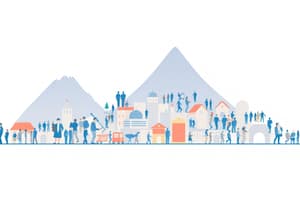Podcast
Questions and Answers
A country with a large number of dependents may face increased pressure to:
A country with a large number of dependents may face increased pressure to:
- Provide social services such as healthcare and education. (correct)
- Increase military spending to protect its borders.
- Decrease the retirement age to reduce pension costs.
- Encourage emigration to reduce the population size.
Which characteristic is most indicative of a population in Demographic Transition Model (DTM) Stage 2?
Which characteristic is most indicative of a population in Demographic Transition Model (DTM) Stage 2?
- Falling birth rate and low death rate, resulting in slow population growth.
- Low birth rate and low death rate, resulting in slow population growth.
- High birth rate and falling death rate, resulting in rapid population growth. (correct)
- High birth rate and high death rate, resulting in a stable population.
A contractive population pyramid, which features a narrow base and a wider top, suggests that a country is most likely experiencing:
A contractive population pyramid, which features a narrow base and a wider top, suggests that a country is most likely experiencing:
- A high birth rate and a youthful population.
- A stable population with equal numbers in each age group.
- A low birth rate and an aging population. (correct)
- A high rate of immigration.
Which of the following is the most likely consequence of a continued low birth rate in a country?
Which of the following is the most likely consequence of a continued low birth rate in a country?
What combination of factors would most likely cause a country to transition from Stage 2 to Stage 3 of the Demographic Transition Model (DTM)?
What combination of factors would most likely cause a country to transition from Stage 2 to Stage 3 of the Demographic Transition Model (DTM)?
What is the primary reason why many immigrants choose to settle in large cities such as Toronto, Vancouver, and Montreal?
What is the primary reason why many immigrants choose to settle in large cities such as Toronto, Vancouver, and Montreal?
The Canadian Point System for skilled workers prioritizes which of the following factors?
The Canadian Point System for skilled workers prioritizes which of the following factors?
What is a potential disadvantage of cultural enclaves for new immigrants?
What is a potential disadvantage of cultural enclaves for new immigrants?
Which land use type typically occupies the largest percentage of urban areas?
Which land use type typically occupies the largest percentage of urban areas?
What is the main goal of Canada's multiculturalism policy?
What is the main goal of Canada's multiculturalism policy?
How do push and pull factors influence migration patterns?
How do push and pull factors influence migration patterns?
Which of the following factors primarily accounts for the majority of population growth occurring in developing countries?
Which of the following factors primarily accounts for the majority of population growth occurring in developing countries?
Which demographic indicator is calculated using the following formula: (Immigrants ÷ Population) × 1000?
Which demographic indicator is calculated using the following formula: (Immigrants ÷ Population) × 1000?
A country with a birth rate of 25 per 1,000 and a death rate of 10 per 1,000 would have a natural increase rate of:
A country with a birth rate of 25 per 1,000 and a death rate of 10 per 1,000 would have a natural increase rate of:
According to the Demographic Transition Model (DTM), which characteristic is most typical of Stage 4?
According to the Demographic Transition Model (DTM), which characteristic is most typical of Stage 4?
Which of the following factors is most likely to contribute to a country entering Stage 5 of the Demographic Transition Model (DTM)?
Which of the following factors is most likely to contribute to a country entering Stage 5 of the Demographic Transition Model (DTM)?
Which of the following scenarios would result in the highest population doubling time, assuming all other factors remain constant?
Which of the following scenarios would result in the highest population doubling time, assuming all other factors remain constant?
Which scenario best exemplifies the concept of 'Net Migration'?
Which scenario best exemplifies the concept of 'Net Migration'?
What would be the primary effect of a country's government implementing policies that strongly encourage families to have more children?
What would be the primary effect of a country's government implementing policies that strongly encourage families to have more children?
How does increased urbanization typically impact population trends in developing countries?
How does increased urbanization typically impact population trends in developing countries?
Flashcards
Population Pyramid
Population Pyramid
A bar graph showing population distribution by age groups and gender.
Dependents (Population)
Dependents (Population)
Individuals under 15 or over 64, typically not in the workforce.
Expansive Pyramid
Expansive Pyramid
Pyramid with a wide base and narrow top, indicating high birth rates and short life expectancy.
Stationary Pyramid
Stationary Pyramid
Signup and view all the flashcards
Contractive Pyramid
Contractive Pyramid
Signup and view all the flashcards
Immigration
Immigration
Signup and view all the flashcards
The Point System (Canada)
The Point System (Canada)
Signup and view all the flashcards
Cultural Enclaves
Cultural Enclaves
Signup and view all the flashcards
Land Use (Urban)
Land Use (Urban)
Signup and view all the flashcards
Multiculturalism
Multiculturalism
Signup and view all the flashcards
Push Factors
Push Factors
Signup and view all the flashcards
Pull Factors
Pull Factors
Signup and view all the flashcards
Population Trends
Population Trends
Signup and view all the flashcards
Fertility Rate
Fertility Rate
Signup and view all the flashcards
Birth Rate
Birth Rate
Signup and view all the flashcards
Death Rate
Death Rate
Signup and view all the flashcards
Life Expectancy
Life Expectancy
Signup and view all the flashcards
Migration
Migration
Signup and view all the flashcards
Demographic Transition Model
Demographic Transition Model
Signup and view all the flashcards
DTM Stage 1: Pre-Industrial
DTM Stage 1: Pre-Industrial
Signup and view all the flashcards
Study Notes
- Population pyramids are bar graphs displaying population distribution by age groups (5-year intervals) and gender (males on the left, females on the right).
- Population pyramids reveal a country’s age structure and predict future needs, indicate population growth trends (growing, shrinking, or stable).
- The key population groups are dependents: young (under 15) and elderly (over 64) who typically do not work, increasing pressure on the country to provide services.
Types of Population Pyramids
- Expansive pyramids feature a wide base and narrow top.
- Expansive pyramids indicate many young people, high birth rate, fast population growth, and short life expectancy, typically in developing countries (DTM Stage 2).
- Expansive pyramids lead to a need for more schools, childcare, food, and create challenges in providing enough jobs later with high birth rates correlating to high Natural Increase Rate.
- Stationary pyramids showcase almost equal widths across most age groups.
- Stationary pyramids reflect low birth and death rates, stable population, and longer life expectancy, commonly found in developed countries (DTM Stage 4).
- Stationary pyramids result in stable demand for services and a focus on quality of life rather than just growth.
- Contractive pyramids have a narrow base and wider middle/top sections.
- Contractive pyramids demonstrate fewer children and more seniors with low birth rates leading to shrinking populations, usually in very developed (post-industrial) countries.
- Contractive pyramids result in fewer workers, more healthcare needs for the elderly, and increased pension/retirement costs.
Immigration
- Immigration happens when people move into a country to live permanently.
- People immigrate to Canada for safety, freedom, education, jobs, healthcare, and a better life.
- Immigrants settle in big cities like Toronto, Vancouver, and Montreal for job opportunities and cultural communities (support).
The Point System (Skilled Workers)
- The point system totals 100 points and requires 67+ to qualify.
- Point system categories include education (out of 25), language (out of 28), work experience (out of 15), age (18–35 is best, out of 12), job offer in Canada (out of 10), and adaptability (spouse’s skills, relatives, out of 10).
- Family Class immigration involves sponsorship by relatives and does not require points.
- Immigrant refugees are those escaping danger and are protected under law.
- Business Immigrants must invest or create jobs and need experience and money.
Cultural Enclaves
- Cultural enclaves are areas where many people from the same culture live together, such as Chinatown and Little India.
- The pros of cultural enclaves are shared language, food, customs, emotional support, and easy transition for newcomers.
- The cons of cultural enclaves are that residents might not learn English/French quickly and experience less mixing with Canadian culture (can feel isolated).
Land Use in Urban Areas
- Residential land use accounts for 40% of a city, including homes and condos.
- Transportation land use accounts for 32% of a city, including roads and subways.
- Institutional land use accounts for 10% of a city, including schools and hospitals.
- Open Space land use accounts for 7% of a city, including parks and fields.
- Industrial land use accounts for 6% of a city, including factories.
- Commercial land use accounts for 5% of a city, including stores and malls.
- Cities are planned for balance (living, working, travel, fun).
- Planning helps avoid overcrowding or traffic problems.
Multiculturalism
- Multiculturalism is the official Canadian policy that supports people keeping their own culture while joining Canadian life.
- Multiculturalism makes immigrants feel welcomed and accepted.
- Multiculturalism promotes respect for all religions, languages, and traditions.
- Multiculturalism is part of Canada’s identity, which is known to be inclusive and diverse.
Push and Pull Factors
- Push factors (reasons people leave) are war, violence, poverty, no jobs, bad healthcare or education, discrimination, and politics.
- Pull factors (reasons people come) are safety, peace, better jobs, good schools and hospitals, and freedom (speech, religion).
Population Trends
- Population trends are the direction and rate of change in a population over time, including changes in birth rates, death rates, life expectancy, and migration.
- Most population growth occurs in developing countries due to limited access to birth control, high child mortality rates, and lower education/job opportunities for women, leading to earlier marriages and more children per family.
- Urbanization leads to more people moving to cities, often for jobs or services.
- Aging populations in developed countries result in fewer babies being born.
- The number of seniors increases, which slows down or reverses growth in developed countries.
- Fertility Rate: The average number of children a woman is expected to have.
- Growth Rate: The rate at which a population is increasing or decreasing per year.
- Birth Rate: The number of births per 1,000 people.
- Death Rate: The number of deaths per 1,000 people.
- Life Expectancy: The average number of years a person is expected to live.
- Migration: The movement of people from one area to another (immigration = in, emigration = out).
Demographic Indicators
- Birth Rate equals (Births ÷ Total Population) × 1000.
- Death Rate equals (Deaths ÷ Population) × 1000.
- Natural Increase equals Birth Rate – Death Rate.
- Immigration Rate equals (Immigrants ÷ Population) × 1000.
- Emigration Rate equals (Emigrants ÷ Population) × 1000.
- Net Migration equals Immigration Rate – Emigration Rate.
- Population Growth Rate (%) equals Natural Increase + Net Migration.
- Doubling Time (yrs) equals 70 ÷ Growth Rate.
Demographic Transition Model (DTM)
- The Demographic Transition Model shows how a country’s population changes over time as it develops economically.
- It has 5 stages, based on birth rates, death rates, and population growth:
- Stage 1: Pre-Industrial
- High birth rate.
- High death rate.
- Population stays small and stable.
- This is due to poor healthcare, no family planning, and many children die young.
- Stage 2: Early Industrial
- High birth rate.
- Falling death rate.
- Population grows quickly.
- This is due to better food, medicine, and sanitation, but families still have many kids.
- Stage 3: Late Industrial
- Falling birth rate.
- Low death rate.
- Population growth slows.
- This is due to more education, better jobs (especially for women), and access to birth control.
- Stage 4: Post-Industrial
- Low birth rate.
- Low death rate.
- Population is stable or slightly shrinking.
- This is where people choose to have fewer kids and lifestyle changes.
- Stage 5: Declining? (Some countries)
- Very low birth rate.
- Low death rate.
- Population declines.
- This is due to an aging population and not enough babies replacing people.
- Stage 1: Pre-Industrial
Studying That Suits You
Use AI to generate personalized quizzes and flashcards to suit your learning preferences.




